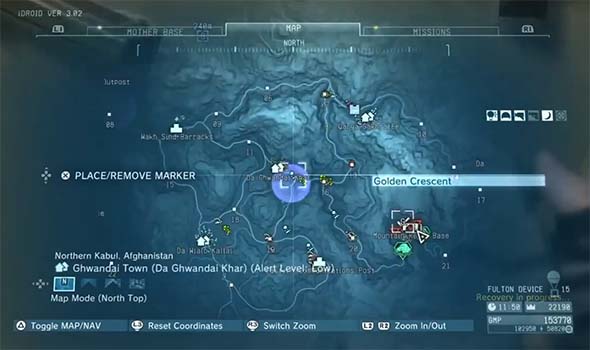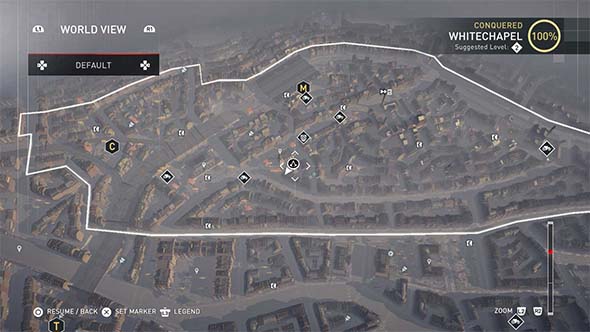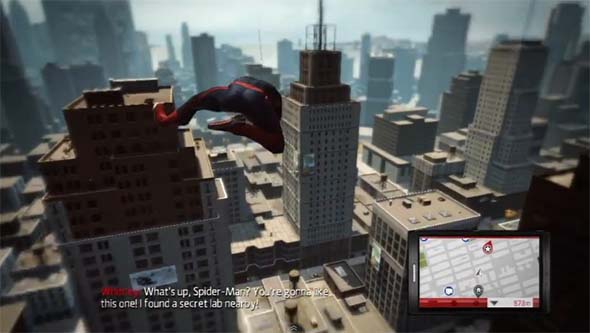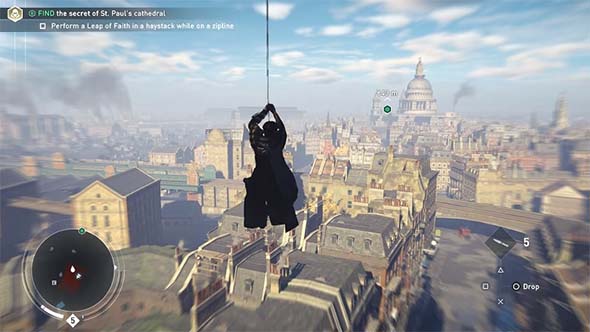I wrote a lengthy blog late last year about the stagnant, "limbo"-like feel of most open world games' narratives. I had written that blog mostly before I played Metal Gear Solid V, and so I wasn't able to incorporate my thoughts regarding that game into the blog. But I did come to a new realization about open world gaming while I was playing MGSV. In my review of that game, I noted that:
"Even the open world itself feels constrained, as sheer cliffs prevent you from travelling too far off of the roads and serve to functionally railroad the player towards the small set-piece outposts and villages."
- from my Metal Gear Solid V: the Phantom Pain review
I realized while playing MGSV that the game had built this large, open world (well, two large, open worlds really, but I hadn't gotten that far yet), but it didn't really care to let the player actually traverse that space or use it in any meaningful way other than scavenger hunting for collectibles. At least those collectibles felt relevant to gameplay though! Roughly half the map is dead space that the player can't even access. There was also this strange focus on using the helicopter to drop in and drop out of missions, rather than actually living in the game world, as the character had to do in Snake Eater. The map started to feel less and less like a place, and more like a convoluted mission-select screen. At first, this seemed like a strange, isolated example of an open world game that really doesn't want the player actually exploring its world. But as I thought about it, I realized that this isn't really a new phenomenon; it's actually just a very extreme example of what has become a sort of defacto state in most open world games.

The Afghanistan map of Metal Gear Solid V feels heavily constrained by sheer cliffs.
Think about it this way: in a linear game with rooms and corridors, every hallway and room should serve some purpose or function. In most games, this function will be some kind of skill or system mastery test. An action game like Devil May Cry will throw enemies at you to fight; a puzzle game like Portal will have a puzzle (or a piece of a puzzle) in the room to solve; a stealth game like Metal Gear Solid 3 will have a sneaking challenge or obstacle to pass; and so on. In the best games, each of these challenges will also provide a unique or novel test of skill or system mastery: unique combinations of enemies, unique puzzles, or novel arrangements of enemies and obstacles. Other games can use those rooms for thematic or narrative purposes. A survival horror game like Resident Evil or Silent Hill will usually put enemies, puzzle items, or supplies in a room, but some rooms might instead contain a scripted scare. In some cases, a room might even be left completely empty in order to build some kind of tension or anticipation, or to delay the release of already-built tension or anticipation.
So what is the gameplay purpose of an open world map? If designing each and every corridor or room of a linear game such that it engages the player in a game system or mechanic, or to progress the narrative or theme of the game, then shouldn't an open world map (as a whole) follow the same philosophy? I think that it should. An open world map should engage the player in some game mechanic. It should provide some skill or system mastery challenge. Whether that be resource-management, navigational challenges, puzzles and obstacles to overcome, or the use of some novel game mechanic, it should do something. At the very least, the map (and the act of moving about within it) should feel thematically relevant.
The map as a checklist and mission select screen
Bethesda's games - which are probably the poster-child for "exploratory" open world games - aren't really designed with the intent of the player traversing that world. Much - if not most - of the open world serves simply as space in between landmarks and quests. Those design principles for linear games that I cited above are usually present in the towns and linear dungeons that are peppered around the map, but those principles don't necessarily apply to the map as a whole. Sure that space may occasionally yield hidden goodies or enemy encounters, but exploring the map is never really about the exploration. It's about reaching a destination, at which point the "game" begins. Do you even bother to continue to walk across the map once you've unlocked the ability to fast travel to where you want to go? Probably not. The reason is that the space itself, the distances between locations, and their physical placement relative to one another, is not really important or worthwhile in its own right. Only the task or landmark or event that happens there is important. Once that task or quest or ambient event is finished, that location or space on the map becomes meaningless, there's no reason to ever go back, and the space between it and any other nearby landmarks is probably never used or seen again. Since there's no constraints on time or resources, you're free to fast travel wherever you want, whenever you want, with no regard for finding optimal paths or navigating obstacles. In fact, the optimal path is almost always to walk in a straight line towards your destination, and game puts up virtually no resistance or obstacles other than a handful of impassable mountains.
Bethesda's Elder Scrolls and Fallout games, despite their weaknesses, are still a light-year ahead of Ubisoft's open world game design (pioneered by the Assassin's Creed franchise) thanks mostly to Bethesda's skill at environmental story-telling and the way in which their worlds typically feel lived-in. The worlds of Assassin's Creed, on the other hand, feel very lifeless and sterile. The maps have also begun to feel over large and bloated, with very little of the game's content feeling meaningful. They have gradually become less and less about traversing space and learning the lay of the land, and have become more and more about simply being a massive mission-select screen and a checklist for item collectibles. While the first game was about using the free-running mechanics to explore the city to find your target, then following the target to an appropriate ambush location, and then escaping to safety, the later games have leaned more and more on herding the player towards small set pieces in which the assassinations occur as scripted events that are book-ended with cutscenes.

The map of Assassin's Creed: Syndicate is more of a mission-select screen
and collectibles checklist than an actual game world to explore.
In the first game, navigating the space, identifying places to hide and viable escape routes was a primary gameplay mechanic. Knowing the map was important. The geography of the game map was a factor in how you play the game, and taking the time to learn that geography was a key to high-level play. Free play exploration felt much more purposeful. Each city's map was appropriately sized and scaled to allow the player to learn it in great detail. In the later games, the worlds have gotten much bigger, and all that extra space has gone mostly wasted, as it is little more than just an obstacle that you walk across to get to the next mission marker. There's less need to recon an area prior to a mission, because the games are designed to line up everything you need in the path that you're expected to follow. The missions themselves feel more and more like guided action set-pieces that take away your ability to explore and force you into running linear paths. This is why the games have loaded the map with so many collectibles, because otherwise the majority of the map would just feel like wasted, empty space. But once you've collected those items, that space can be completely forgotten, as it's never going to be useful ever again. The maps have gotten so big, and so bloated, and so much of the space is so irrelevant, that the latest game, Assassin's Creed: Syndicate, eventually gives the player a zip line tool that allows you to completely avoid having to navigate the city.
Unfortunately, Ubisoft's model seems to have become an industry standard, such that other developers have begun copying and re-skinning it with little or no thought. Avalanche Studios copies Ubisoft's formula practically verbatim with Mad Max, and Pandemic based its map for The Saboteur heavily off of Ubisoft's formula as well (though I think The Saboteur pulls it off a little bit more creatively).
Turf wars
Another gameplay mechanic that is becoming prevalent in open world and sandbox games is "base capture". Many of these games involve some sort of faction conflict, in which parts of the map are controlled by one group or the other, and the player is often tasked with assaulting the bases controlled by enemies in order to "liberate" a region of the map. This sounds (on paper at least) like it would be a great way to make the game's map and geography feel meaningful, and so games and franchises like Assassin's Creed, Far Cry, Just Cause, Mafia, The Saboteur, Mad Max, and so on have all involved the player capturing territory from rival factions as an excuse to try to get the player out into the game world. But these features often fall flat because they end up just being more to-do items on a checklist: you clear the base, and then that's it. The rival factions never fight to recapture them, the captured bases never act as staging points for assaulting neighboring bases (and so they have no strategic value), and so no thought or planning goes into the process of base-capture. There's very little (if any) sense of conflict, and the location or relative positions of the captured bases means next to nothing.
Many games (including Far Cry and Mad Max) involve "liberation" mechanics,
but the enemy factions never put up any fight or attempt to recapture lost territory.
These games try to justify such activities with mechanics that despawn enemies in a region around a captured base. This is supposed to incentivize players into capturing the bases in order to make travel through the region less hazardous. The difference, however, often feels negligible. Adding the ability to fast-travel between such bases or regions also emphasizes that the point isn't to provide any kind of mastery challenge to the player, but rather to eliminate tedious, mundane backtracking. Well, that backtracking could also have been eliminated by simply shrinking the map and cutting the repetitive content. Then players might actually use that space that your developers spent so much time and money creating (instead of skipping past it with a loading screen).
Fallout 4 has a mechanic in which your settlements can be raided by bandits or attacked by Super Mutants or Deathclaws. You must set up proper defenses and arm your settlers so that they can protect themselves, but these attacks will often require the player's intervention regardless. Sadly, the game usually allows you to fast travel directly to the settlement to resolve the situation at a moment's notice. You don't get advanced warning to notify you of a pending threat, nor are you given the time to finish what you're currently doing and return to the settlement to defend it. This means that the mechanic feels more like a tedious chore that serves only to pull you away from what you're presently doing, than any sort of strategic gameplay system. You don't plan your exploration or questing routes to keep you close to your vulnerable settlements. The placement of your settlements and their relative location from each other is completely irrelevant, and even this feature fails to use the map in any meaningful way.
Map-traversal as a skill challenge
Another blatant example of an "open world" game eliminating the need to traverse its space is the video game tie-in for the Amazing Spider-Man movie. The game went back to including an open New York for Spider-Man to web-swing around. But the web did not need to attach to buildings, and Spidey could web swing far above the skyline. The fact that you could effectively fly over buildings meant that the actual placement, size, and arrangement of the buildings was irrelevant. Moving around the space had no challenge; you just pointed in a direction and go there. Even the collectible comic book pages (which actually unlocked fully readable versions of entire issues of Spider-Man comics - one of the best unlockables in any game ever!) simply required pointing Spidey in their direction and pushing a single button. At least the Grand Theft Auto games require that you navigate around buildings, and through traffic, providing a constant (though admittedly dull) skill challenge for the player. In Amazing Spider-Man, you can just completely zone out while moving around the city.

The skyscrapers of New York didn't act as an obstacle to movement in the first Amazing Spider-Man game.
The sequel took some steps to address this by requiring Spidey to be closer to buildings and lower to the ground to use his webs, and moving around in that game was a lot more interesting and fun, since you actually had to navigate around buildings and obstacles instead of swinging over them. In addition, that game also mapped Spidey's left and right web shooters to the left and right triggers, respectively, which added additional control and an extra element of having to "think like Spider-Man". Suddenly, there was a skill element again! Unfortunately, the rest of the game was an utter mess, and it wasn't nearly as fun as the classic Spider-Man 2 movie tie-in game. Simply swinging around the city was an absolute blast in that older game, which even awarded you with style points for performing tricks while simply navigating its environment.
But perhaps a more universally-recognizeable example of space-traversal as a challenge comes in the form of driving or racing games. Games like Midnight Club, Burnout: Paradise, or The Crew do make navigation a central challenge of the game with its focus on a vehicle as the means of transit. Even though these games' maps can be looked at as being simply a mission-select screen (which many of them are), the fact that you have to control a vehicle means that navigating between missions and quest-givers is, itself, a skill challenge.
That doesn't mean that it can't become tedious though. In order for such a game's open world map to really work, the developers still need to make good use of the space that is provided. How much of the map is used by races or other challenges can be the variable on which these games' maps live or die. The reason for this is that you aren't necessarily racing from mission to mission in the overworld. A half-throttle trot or canter across the map has a very low skill floor and provides virtually no challenge. So such a game still needs to find a way to make that time spent traveling between missions feel relevant, and that will often be the difference between a good racing game and a bad racing game.

No, holding a single button to run up and down walls in a straight line path, or using a zipline,
does not constitute a navigational skill challenge!
The paradox of open world sandboxes
The flaw in these games is that, despite the open world being a major element of the game's design and marketing, movement within that open world's space is trivial and mostly devoid of mechanical relevance. The space itself is devoid of meaning and isn't worth anything in its own right. The entire map feels almost like a complicated and tedious mission-select screen or checklist, while the missions (or quests) themselves sometimes take place in confined set-piece encounters that are often separate from the overworld used to reach them, and the relative placement and distances between landmarks is moot. There's rarely any challenge or limitations to navigating the environment, and the game usually provides ways for the player to avoid traversing the space entirely. The game isn't really about playing in that world as much as it is about simply reaching the confined and narrow places that the world contains. Traveling within the world feels mostly like a time-sponge of filler content rather than an actual part of the game.
This discussion isn't over yet. In my next post, I plan to look at examples of games that do make good use of their open world space, and which can offer examples and lessons for other developers to learn from. So if this post felt a little negative and cynical, then the next post should offer some more optimistic, constructive criticism. Until then, happy gaming!